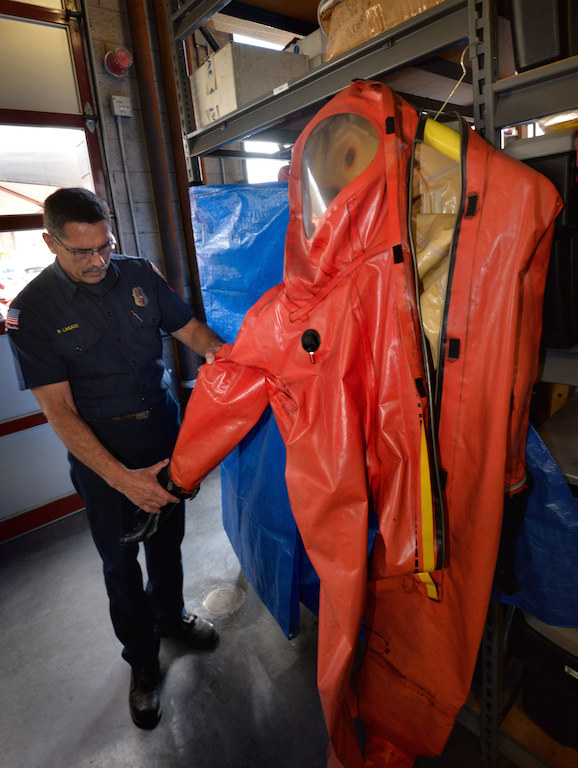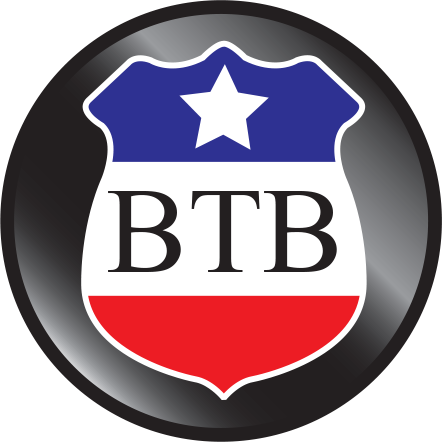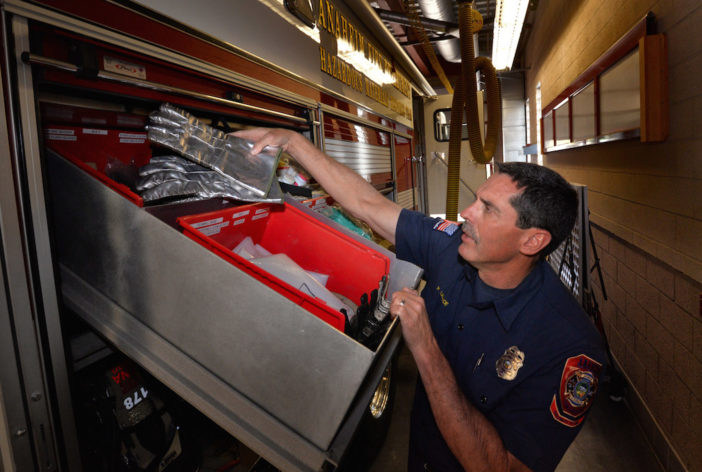It is a chilling scenario. You are opening personal or business mail when suddenly confronted with the dreaded “white powder,” or some other unknown substance.
Although the chances of it being anything but a hoax are remote, that doesn’t make the initial discovery any less terrifying.
Recently, first responders had to react to potential hazardous materials at Children’s Hospital of Orange County (CHOC). Attacks and threats of ricin, anthrax, and other toxins and agents being sent via mail date back to the 1970s and peaked in the early 2000s after September 11, with several high-profile attacks and attempts.
Ever since, the potential of biological attacks, despite their rarity, is taken extremely seriously.

In this Behind the Badge file photo, A Fire Engineer with Anaheim Fire & Rescue’s Hazardous Materials Response Team displays a hazmat suit that is used for training.
File photo by Steven Georges/Behind the Badge
False alarm at CHOC
In May, at CHOC, several public safety agencies responded to “potential hazmat concerns.” Personnel from Orange, Anaheim, Orange, and Huntington Beach, along with the Orange County Sheriff’s Department bomb squad, FBI and OC Health.
A statement posted to the Orange City Fire Department’s Facebook page read that a hospital staff member received an envelope with an unknown white powder.
“Ultimately, only two patients were transported to the hospital,” the statement read, although 10 patients were examined for possible exposure.
Chief Nick Freeman, who oversees the Hazard Materials operations for the Orange County Fire Authority, said hazmat responses are viewed as serious.
“We treat all white powder as legit until we learn otherwise,” he said.
Generally, hazmat response consists of dispatching a regularly trained eight-person team in full protective gear. The team tests the substances to learn whether the substance is a biological hazard or something else. Victims are transported to a hospital for appropriate treatment if needed.
The vast majority of instances are hoaxes or even simple mistakes. However, Freeman said, taxpayers pick up the cost for staff time, training, and gear. When a substance is hazardous, Freeman said costs escalate rapidly.
In a statement, CHOC wrote, “we initiated a precautionary response to a potential Hazmat concern in a nonpatient area of one of our buildings. After a thorough evaluation, authorities have determined there are no hazardous conditions.”
The substance was not disclosed.
Such instances are not mere pranks. They are felonies punishable by a fine and up to five years in prison, or both. In the case of injuries or death, the penalties can range from 20 years to life.
“Even sending a hoax letter is a serious crime and law enforcement will continue to work to identify and arrest those responsible,” the FBI states.
Hoax frenzy
Anthrax gained national attention after spores were mailed in the wake of the 9/11 terrorist attacks leading to five deaths and 22 infections. Since then actual attacks are virtually unknown, although fear remains.
Ricin, derived from castor beans, can be inhaled, dissolved, or ingested in food. Ricin has been used in a number of terrorist and international espionage attacks and attempts. It is a potent poison that has been studied as a bioterrorism agent.
A ricin-laced letter was sent targeting President Barack Obama in 2013 and as recently as 2020 a ricin-contaminated letter was sent to the White House. During the recent federal election cycle, suspicious packages containing white powder were sent to officials in at least six states, although none contained hazardous material.
Freeman said “white powder” calls are fairly common occurrences, although they have abated considerably in recent years. In the wake of the anthrax scare in 2001, Freeman said the situation was out of control.
“We were getting 10 calls a day,” he said. “It was horrific.”
What to do?
Anyone who encounters a mysterious substance in the mail, with or without a threat, should react quickly.
“The first thing to do is exit the room, and leave the envelope and substance as is,” Freeman said. “Then go to an open air area, call 911, and give as detailed a report as you can.
If you receive a white powder or other suspicious package, officials suggest the following:
- Do not handle the suspicious mail if possible.
- Do not shake or empty the contents of any suspicious envelope or package.
- Do not pass the letter or package to others to examine.
- Make sure the items are isolated and the immediate area is cordoned off.
- Wash hands with soap to prevent possible spread to other parts of your body.
- Avoid touching your skin, eyes, or other mucous membranes.
- List all persons who may have touched the letter and/or envelope and share with authorities.
- Follow directions by emergency personnel for disinfection.
What to look for in any incoming mail:
- Powdery substance on the outside of the letter or package.
- Inappropriate or unusual labeling.
- Excessive postage.
- Handwritten or poorly typed addresses.
- Misspelling of common words.
- Threatening language on package.
- Oily stains, discolorations, or odor.
- Lopsided or uneven envelope.
As in any suspicious incident, caution is advised. For information on suspicious packages, check out the FBI fact sheet.
For more information on safety at home and work, sign up for the SafeOC newsletter and ReadyOC newsletter to receive local updates, public safety alerts, and tips.
 Behind the Badge
Behind the Badge



